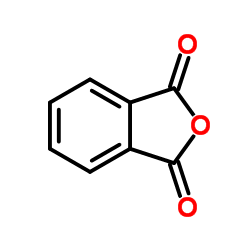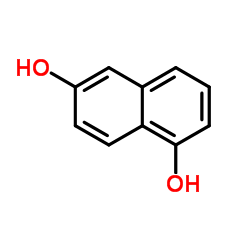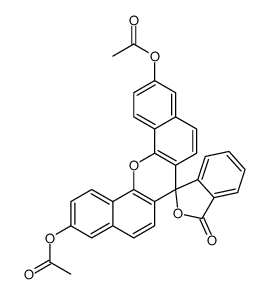Naphthofluorescein

Naphthofluorescein structure
|
Common Name | Naphthofluorescein | ||
|---|---|---|---|---|
| CAS Number | 61419-02-1 | Molecular Weight | 432.424 | |
| Density | 1.6±0.1 g/cm3 | Boiling Point | 755.5±60.0 °C at 760 mmHg | |
| Molecular Formula | C28H16O5 | Melting Point | 189ºC (dec.)(lit.) | |
| MSDS | Chinese USA | Flash Point | 266.4±26.4 °C | |
| Symbol |

GHS07 |
Signal Word | Warning | |
Use of NaphthofluoresceinNaphthofluorescein inhibits the interaction between HIF-1 and Mint3.Naphthofluorescein suppresses Mint3-dependent HIF-1 activity and glycolysis in cancer cells and macrophages without cytotoxicity in vitro and adverse effect in vivo[1]. Naphthofluorescein is also a fluorescent pH-sensitive probe that can be used for functional Cerenkov imaging[2]. |
| Name | Naphthofluorescein |
|---|---|
| Synonym | More Synonyms |
| Description | Naphthofluorescein inhibits the interaction between HIF-1 and Mint3.Naphthofluorescein suppresses Mint3-dependent HIF-1 activity and glycolysis in cancer cells and macrophages without cytotoxicity in vitro and adverse effect in vivo[1]. Naphthofluorescein is also a fluorescent pH-sensitive probe that can be used for functional Cerenkov imaging[2]. |
|---|---|
| Related Catalog | |
| Target |
HIF-1[1] |
| In Vitro | Naphthofluorescein (compound 19) (0-10 μM; 24 hours) suppresses the HIF-1 reporter activity in a concentration-dependent manner[1]. Cell Viability Assay[1] Cell Line: HT1080 cells Concentration: 0-10 μM Incubation Time: 24 hours Result: Significantly suppressed the HIF-1 reporter activity in a concentration-dependent manner. |
| In Vivo | Naphthofluorescein (compound 19) (100 mg/kg; i.p.; once daily for 5 consecutive days followed by 2 days off for 2 weeks)does not show weight loss or apparent histological abnormalities in the lung, liver, and kidney, or cause cause severe adverse effects for at least 2 weeks in mice[1]. Naphthofluorescein (compound 19) (100 mg/kg; i.p.; once daily for 5 consecutive days followed by 2 days off for 2 weeks) strikingly suppresses the tumour growth of subcutaneously injected E0771 cells and significantly attenuates tumour growth of MDA-MB-231 and AsPC-1 cells in immunodeficient mice. In turn, naphthofluorescein does not attenuate tumour growth of FIH-1-depleted MDA-MB-231 cells[1]. Naphthofluorescein (compound 19) (100 mg/kg; i.p.; once daily for 5 consecutive days followed by 2 days off for 2 weeks) suppresses tumour growth in human cancer cells in an FIH-1-dependent manner[1]. Animal Model: Male C57BL/6J mice (8 weeks)[1] Dosage: 100 mg/kg Administration: i.p.; once daily for 5 consecutive days followed by 2 days off for 2 weeks Result: Neither showed weight loss or apparent histological abnormalities in the lung, liver, and kidney, or caused cause severe adverse effects for at least 2 weeks in mice. Animal Model: Female C57BL/6J mice (E0771) and BALB/c nude mice (HT1080, MDA-MB-231, and AsPC-1) (6 weeks)[1] Dosage: 100 mg/kg Administration: i.p.; once daily for 5 consecutive days followed by 2 days off for 2 weeks Result: Strikingly suppressed the tumour growth of subcutaneously injected E0771 cells and significantly attenuated tumour growth of MDA-MB-231 and AsPC-1 cells in immunodeficient mice. In turn, naphthofluorescein did not attenuate tumour growth of FIH-1-depleted MDA-MB-231 cells. |
| References |
| Density | 1.6±0.1 g/cm3 |
|---|---|
| Boiling Point | 755.5±60.0 °C at 760 mmHg |
| Melting Point | 189ºC (dec.)(lit.) |
| Molecular Formula | C28H16O5 |
| Molecular Weight | 432.424 |
| Flash Point | 266.4±26.4 °C |
| Exact Mass | 432.099762 |
| PSA | 75.99000 |
| LogP | 5.09 |
| Vapour Pressure | 0.0±2.6 mmHg at 25°C |
| Index of Refraction | 1.861 |
| InChIKey | IXQIUDNVFVTQLJ-UHFFFAOYSA-N |
| SMILES | O=C1OC2(c3ccccc31)c1ccc3cc(O)ccc3c1Oc1c2ccc2cc(O)ccc12 |
| Symbol |

GHS07 |
|---|---|
| Signal Word | Warning |
| Hazard Statements | H315-H319-H335 |
| Precautionary Statements | P261-P305 + P351 + P338 |
| Personal Protective Equipment | dust mask type N95 (US);Eyeshields;Gloves |
| Hazard Codes | Xi: Irritant; |
| Risk Phrases | R36/37/38 |
| Safety Phrases | 26-36 |
| RIDADR | NONH for all modes of transport |
|
~78% 
Naphthofluorescein CAS#:61419-02-1 |
| Literature: Xu, Kehua; Tang, Bo; Huang, Hui; Yang, Guiwen; Chen, Zhenzhen; Li, Ping; An, Liguo Chemical Communications, 2005 , # 48 p. 5974 - 5976 |
|
~% 
Naphthofluorescein CAS#:61419-02-1 |
| Literature: Fischer,O.; Koenig Chemische Berichte, 1917 , vol. 50, p. 1011 |
|
~% 
Naphthofluorescein CAS#:61419-02-1 |
| Literature: Fischer,O.; Koenig Chemische Berichte, 1917 , vol. 50, p. 1011 |
|
~% 
Naphthofluorescein CAS#:61419-02-1 |
| Literature: Fischer,O.; Koenig Chemische Berichte, 1917 , vol. 50, p. 1011 |
|
~% 
Naphthofluorescein CAS#:61419-02-1 |
| Literature: Hoechster Farbw. Patent: DE275897 ; Fortschr. Teerfarbenfabr. Verw. Industriezweige, vol. 12, p. 217 Full Text Show Details Fischer,O.; Koenig Chemische Berichte, 1914 , vol. 47, p. 1078 Chemische Berichte, 1917 , vol. 50, p. 1011 |
|
~% 
Naphthofluorescein CAS#:61419-02-1 |
| Literature: Fischer,O.; Koenig Chemische Berichte, 1917 , vol. 50, p. 1011 |
|
~% 
Naphthofluorescein CAS#:61419-02-1 |
| Literature: Fischer,O.; Koenig Chemische Berichte, 1917 , vol. 50, p. 1011 |
|
O.S. Wolfbeis et al.
Mikrochim. Acta 108 , 133, (1992)
|
| Spiro[7H-dibenzo[c,h]xanthene-7,1'(3'H)-isobenzofuran]-3'-one, 3,11-dihydroxy- |
| 3',11'-Dihydroxy-3H-spiro[2-benzofuran-1,7'-dibenzo[c,h]xanthen]-3-one |
| naphthofluorescein |


![2-(1.6-dihydroxy-[2]naphthoyl)-benzoic acid structure](https://image.chemsrc.com/caspic/346/397883-28-2.png)

 CAS#:77084-71-0
CAS#:77084-71-0![2-(11-Hydroxy-3-oxo-3H-dibenzo[c,h]xanthen-7-yl)benzoic acid structure](https://image.chemsrc.com/caspic/270/51517-45-4.png) CAS#:51517-45-4
CAS#:51517-45-4